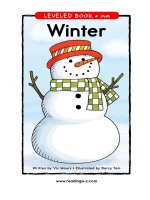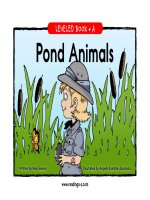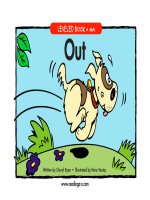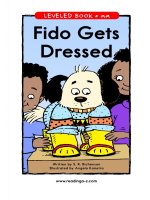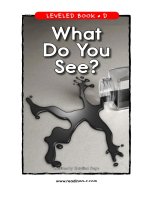raz ll30 owlsoverhead
Bạn đang xem bản rút gọn của tài liệu. Xem và tải ngay bản đầy đủ của tài liệu tại đây (1.85 MB, 18 trang )
Owls Overhead
A Reading A–Z Level L Leveled Book
Word Count: 445
LEVELED BOOK • L
Owls
Overhead
I•L•O
Written by Karen Mockler
Visit www.readinga-z.com
for thousands of books and materials.
www.readinga-z.com
Owls
Overhead
Written by Karen Mockler
www.readinga-z.com
Boreal owlets
Table of Contents
Flying in the Moonlight . . . . . . . . . 4
Eyes for the Night . . . . . . . . . . . . . . 6
Even Better Ears . . . . . . . . . . . . . . . 8
Silent Hunters . . . . . . . . . . . . . . . . 10
Where Owls Live . . . . . . . . . . . . . . 12
Owls Are Out There . . . . . . . . . . . 14
Glossary . . . . . . . . . . . . . . . . . . . . . 16
Owls Overhead • Level L
3
Boreal owlets
Table of Contents
Flying in the Moonlight . . . . . . . . . 4
Tawny owl
Eyes for the Night . . . . . . . . . . . . . . 6
Flying in the Moonlight
Even Better Ears . . . . . . . . . . . . . . . 8
Silent Hunters . . . . . . . . . . . . . . . . 10
Where Owls Live . . . . . . . . . . . . . . 12
Owls Are Out There . . . . . . . . . . . 14
Glossary . . . . . . . . . . . . . . . . . . . . . 16
Owls Overhead • Level L
3
It’s a quiet, moonlit night. You walk
along the edge of town. A shadow
crosses your path, but you hear no
sound. You look up as a dark shape
floats over you and into the nearby
trees.
4
It’s an owl. More than two hundred
different species of owls live around
the world. They come in many
sizes and live on every continent
except Antarctica. Owls may seem
mysterious, but the way they look
and act helps them survive.
Long-eared owls
Owls Overhead • Level L
5
It’s an owl. More than two hundred
different species of owls live around
the world. They come in many
sizes and live on every continent
except Antarctica. Owls may seem
mysterious, but the way they look
and act helps them survive.
Northern hawk owl
Burrowing owl
Eyes for the Night
Like most birds, owls can’t move
their eyes. Instead, they must turn
their heads to follow a moving
object. Owls are able to turn their
heads almost all the way around.
They can even turn their heads
upside down.
Long-eared owls
Owls Overhead • Level L
5
6
An owl’s pupils are small in bright light (top) and large in low light (bottom).
Owls’ big eyes help them survive,
too. Owls can’t see in total darkness,
but they can see better in low light
than most animals. That’s because
of their pupils—the black circles in
the center of their eyes. Their pupils
can grow large to let in more light.
Owls Overhead • Level L
7
Owl skull
Upper ear
Lower ear
Owls have very large ears, which are hidden
under feathers. Some owls have thin skin
that covers the ears’ openings.
Even Better Ears
An owl’s pupils are small in bright light (top) and large in low light (bottom).
Owls’ big eyes help them survive,
too. Owls can’t see in total darkness,
but they can see better in low light
than most animals. That’s because
of their pupils—the black circles in
the center of their eyes. Their pupils
can grow large to let in more light.
Owls Overhead • Level L
7
Most owls rely on their hearing to
hunt. Most owls have huge ears,
with one higher than the other.
The higher ear hears sounds from
above. The lower ear hears sounds
from below. Owls can move the
feathers around their faces to send
more sound to one ear or the other.
This helps them find prey.
8
Owls, such as this
barn owl, often crush
their prey with their
strong feet and
sharp claws. The grip
of some owls can be
ten times stronger
than a human’s grip.
Great gray owls can
Owl pellet
hear a mouse hidden
Pellets!
under the snow.
Owls can’t chew their
food. Instead, they
Barn owls can hear
often swallow small
a mouse moving far prey whole. They can’t
digest the unwanted
away and catch one
parts of the animals. A
of their stomach
in complete darkness. part
with strong muscles rolls
These owls have the those parts into small
balls, called pellets. A
best hearing of any
few hours after they eat,
owls cough up a pellet.
animal ever tested.
Owls Overhead • Level L
9
Owls, such as this
barn owl, often crush
their prey with their
strong feet and
sharp claws. The grip
of some owls can be
ten times stronger
than a human’s grip.
Great gray owls can
Owl pellet
hear a mouse hidden
Pellets!
under the snow.
Owls can’t chew their
food. Instead, they
Barn owls can hear
often swallow small
a mouse moving far prey whole. They can’t
digest the unwanted
away and catch one
parts of the animals. A
of their stomach
in complete darkness. part
with strong muscles rolls
These owls have the those parts into small
balls, called pellets. A
best hearing of any
few hours after they eat,
owls cough up a pellet.
animal ever tested.
Owls Overhead • Level L
9
A saw-whet owl flies silently through the trees.
Silent Hunters
Many animals that owls hunt also
have very good hearing. So if an
owl wants to eat, it must attack
by surprise. The soft feathers that
cover owls’ bodies help them fly
without a sound.
10
Great horned owls are great hunters. They can even catch another bird
in flight.
The main food for most owls is
small animals—lots of them.
A hungry great gray owl may eat
1,400 mice in a year. In its lifetime, a
barn owl may eat 11,000 mice!
Owls Overhead • Level L
11
A barn owl lives up
to its name by raising
its young in a barn.
Where Owls Live
Some owls can live in many different
habitats. Other owls need a special
habitat, though. Burrowing owls live
mostly on the prairie, making their
nests underground. They use old
burrows dug by other animals.
Sometimes they move into fields
and golf courses, and even near
airport runways.
Great horned owls are great hunters. They can even catch another bird
in flight.
The main food for most owls is
small animals—lots of them.
A hungry great gray owl may eat
1,400 mice in a year. In its lifetime, a
barn owl may eat 11,000 mice!
Owls Overhead • Level L
11
An Owl’s Housekeeper
Screech owls hunt snakes. However,
they bring the blindsnake back to their
nest alive. They let it go inside the
nest, where it eats the insects that
feed on the dead animals stored there.
The snake becomes a housekeeper!
12
Like many other owls, spotted owls do not fly south for the winter.
Spotted owls can only survive in
old forests with huge trees. By
1994, most of their habitat had been
destroyed by logging. Today, few
spotted owls are left.
Owls Overhead • Level L
13
Owl Sounds
Owls aren’t always silent, and they don’t all hoot. They all
make different sounds. A great horned owl can bark like
a dog and meow like a cat. Barn owls don’t hoot—they
scream. Their strange cry and appearance once made some
people think of barn owls as a sign of bad luck.
People take pictures of a great gray owl, the largest owl in the world.
Owls Are Out There
Like many other owls, spotted owls do not fly south for the winter.
Spotted owls can only survive in
old forests with huge trees. By
1994, most of their habitat had been
destroyed by logging. Today, few
spotted owls are left.
Owls Overhead • Level L
13
People don’t often see owls, but
they’re out there. If you’re in the
country and want to find one, try
going out at sunset. Listen for their
calls.
14
Barn owl
If you stay out late enough, people
might think you’re an owl—a night
owl, that is.
Owls Overhead • Level L
15
Glossary
attack (v.)
to act harmfully
toward (p. 10)
habitats (n.)
the place where a
plant or animal
lives (p. 12)
mysterious (adj.) odd; not easy to
understand (p. 5)
prey (n.)
an animal that is
hunted and eaten
by another animal
(p. 8)
species (n.)
a group of living
things that are
similar (p. 5)
survive (v.)
to stay alive (p. 5)
Barn owl
If you stay out late enough, people
might think you’re an owl—a night
owl, that is.
Owls Overhead • Level L
15
16
Owls Overhead
A Reading A–Z Level L Leveled Book
Word Count: 445
LEVELED BOOK • L
Owls
Overhead
I•L•O
Written by Karen Mockler
Visit www.readinga-z.com
for thousands of books and materials.
www.readinga-z.com
Owls
Overhead
Photo Credits:
Front cover: © Manfred Danegger/Science Source; back cover: © Brian Bevan/
ardea.com; title page: © Kim Taylor/Minden Pictures; pages 3, 11: © Wayne Lynch/
All Canada Photos/Superstock; page 4: © Stephen Dalton/Minden Pictures; page 5:
© M. Watson/ardea.com; page 6 (left): © Markus Varesvuo/Minden Pictures;
page 6 (right): © Henrik Nilsson/Solent News/Rex/Rex USA; page 7 (top): © age
fotostock/Superstock; page 7 (bottom): © Claus Meyer/Minden Pictures; pages 8
(main), 9 (inset): © Arterra Picture Library/Alamy; page 8 (inset): © All Canada
Photos/Alamy; page 9 (main): © Rolf Nussbaumer/Minden Pictures; page 10:
© Ron Austing/Frank Lane Picture Agency/Corbis; page 12 (top): © Steve
Maslowski/Visuals Unlimited/Corbis; page 12 (bottom): © Larry Miller/Science
Source; page 13: © Tom Mangelsen/Minden Pictures; page 14: © Harri Taavetti/
FLPA/age fotostock; page 15: © Steve Allen/Dreamstime.com
Front cover: Barn owl
Back cover: Little owl
Title page: Tawny owl
Written by Karen Mockler
Owls Overhead
Level L Leveled Book
© Learning A–Z
Written by Karen Mockler
www.readinga-z.com
All rights reserved.
www.readinga-z.com
Correlation
LEVEL L
Fountas & Pinnell
Reading Recovery
DRA
K
18
20


